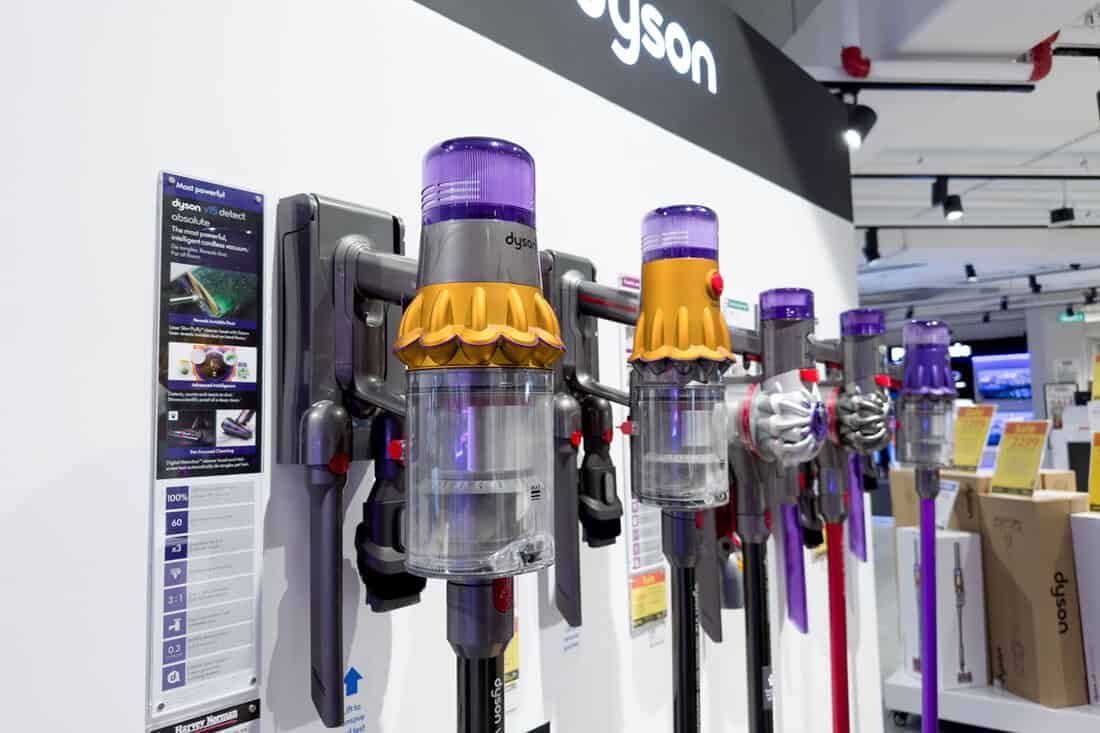The Dyson Animal vacuum cleaner has impressive capabilities when it comes to removing stubborn pet hair and dirt. However, to keep your Dyson Animal running at its best, it's important to regularly clean its filter. Wanna know how? Well, we have research on this matter to help you.
Here is the step-by-step guide on cleaning a Dyson Animal filter:
- Turn off and unplug the vacuum.
- Remove the filter from the vacuum.
- Tap the filter to remove loose debris.
- Wash the filter under running water.
- Clean the filter with a brush.
- Rinse the filter again.
- Squeeze out the excess water.
- Let the filter dry completely.
- Reinsert the filter into the vacuum cleaner.
In this guide, we'll show you just how easy it is to clean a Dyson Animal filter, so you can keep your vacuum cleaner in top-notch condition and keep your home free of pesky pet hair and dust. More information ahead so keep reading.

How To Clean A Dyson Animal Filter?
Dyson Animal vacuums are known for their strong suction power and efficient cleaning capabilities, but like any other vacuum, they need regular maintenance to perform at their best. One crucial aspect of Dyson vacuum maintenance is cleaning the filter.
We sometimes add affiliate links and content that was curated and created by our team with the help of advanced ai tools to help showcase the best design styles.

Over time, the filter becomes clogged with dust, hair, and other debris, which can reduce the suction power and affect the vacuum's performance. Cleaning a Dyson Animal filter is a simple process that can be completed in just a few steps:
1. Turn Off And Unplug The Vacuum
Before cleaning the filter, it's essential to turn off and unplug the vacuum from the power source. This will ensure your safety and prevent any damage to the vacuum.
2. Remove The Filter From The Vacuum
The next step is to remove the filter from the vacuum. To do this, locate the filter on your Dyson Animal vacuum. Depending on the model, the filter can be found on the top or bottom of the vacuum. Once you've located the filter, press the button or release the latch to remove it.
3. Tap The Filter To Remove Loose Debris
Once you've removed the filter, take it outside or to a trash can and tap it gently to remove any loose debris. This will help to loosen up any dust, hair, or other debris that may be stuck to the filter.
4. Wash The Filter Under Running Water
After tapping the filter, wash it under running water. Make sure to use cool water and avoid using any soap or detergent. Hold the filter under the faucet and allow the water to flow through it from the clean side to the dirty side. This will help to wash away any remaining debris from the filter.
5. Clean The Filter With A Brush
If you notice that there are still some stubborn particles on the filter after washing it with water, you can use a soft-bristled brush to gently scrub the filter. This will help to remove any remaining dirt or dust that may be stuck to the filter.
Click here to see this soft-bristled brush on Amazon.
6. Rinse The Filter Again
Once you have finished cleaning the filter with water and a brush, rinse it again under cold running water to remove any remaining debris or soap residue.
7. Squeeze Out The Excess Water
Once you've finished rinsing the filter, gently squeeze out any excess water by pressing it between your hands. Do not twist or wring the filter as it can damage the delicate fibers.
8. Let The Filter Dry Completely
Leave the filter to air dry for at least 24 hours before putting it back in the vacuum cleaner. Do not use a hairdryer or any other heat source to speed up the drying process as this can also damage the filter.
9. Reinsert The Filter Into The Vacuum Cleaner
Once the filter is completely dry, you can put it back into the vacuum cleaner. Make sure it is properly secured before turning the vacuum cleaner back on.
For a more comprehensive understanding of the processes above, an instructional video on YouTube is shown below.
How Often Should I Clean A Dyson Animal Filter?

The frequency with which you should clean your Dyson Animal filter depends on how often you use your vacuum cleaner and the level of dust and debris in your home.
As a general rule, it's recommended to clean the filter at least once every three months to ensure maximum performance and suction power.
However, if you have pets or if your home is particularly dusty or prone to allergens, you may need to clean the filter more frequently. In some cases, it may be necessary to clean the filter once a month or even more often.
To determine how often you should clean your Dyson Animal filter, pay attention to the performance of your vacuum cleaner.
If you notice that it's not picking up dirt or pet hair as effectively as it used to, or if you notice that the suction power seems to be decreasing, it may be time to clean the filter.
Regularly cleaning your Dyson Animal filter will help ensure that your vacuum cleaner continues to operate at its best, removing dirt and allergens from your home and keeping your air clean and fresh.
How Often Should I Replace My Dyson Vacuum Filter?
Over time, the filters in a Dyson vacuum can become clogged with dirt and debris, which can reduce the suction power of the vacuum and make it less effective at picking up dust, pet hair, and other particles.
The frequency of replacing your Dyson vacuum filter depends on several factors, including the type of Dyson vacuum you own, how often you use it, and how dirty your home is.
Here are some general guidelines to help you determine when it's time to replace your Dyson vacuum filter:
Check The Filter Regularly
You should inspect the filter every month or so, especially if you use your vacuum frequently or have pets in your home. Look for signs of dirt and debris, and check to see if the filter is discolored or has an odor.
Determine The Type Of Filter You Have
Dyson vacuums come with different types of filters, including pre-motor filters, post-motor filters, and HEPA filters. The type of filter you have will determine how often you need to replace it.
Pre-motor filters are usually washable and can last up to six months with proper maintenance, while post-motor filters and HEPA filters need to be replaced every six to twelve months.
Consider Your Home's Air Quality
If you or someone in your household has allergies or respiratory issues, you may need to replace your Dyson vacuum filter more frequently.
HEPA filters are designed to capture tiny particles like pollen, pet dander, and dust mites, which can trigger allergies and asthma symptoms. If you have a lot of these particles in your home, you may need to replace your filter every three to six months.
Pay Attention To The Suction Power Of Your Vacuum
If you notice that your Dyson vacuum is losing suction power, it may be time to replace the filter. A clogged filter can reduce the efficiency of your vacuum, which can make it less effective at picking up dirt and debris.
If you've tried cleaning the filter and your vacuum still isn't performing as well as it should, it's probably time for a replacement.
Follow The Manufacturer's Recommendations

Finally, it's always a good idea to follow the manufacturer's recommendations for replacing your Dyson vacuum filter.
You can find this information in the owner's manual that came with your vacuum or on the Dyson website. Dyson recommends replacing filters every 12 months to maintain optimal performance.
Where You Can Purchase Filter Replacement For Your Dyson Vacuum?
There are various places where you can purchase filter replacement for your Dyson vacuum, including:
Dyson's Official Website

The first place to look for Dyson filter replacement is the brand's official website. Dyson offers a wide range of filters for its vacuums, including pre-motor, post-motor, and HEPA filters.
You can browse the filters by model or type and purchase them directly from the website. Dyson offers free shipping on all orders over $50 and provides a 30-day return policy.
Amazon

Amazon is another popular option to purchase Dyson vacuum filter replacements. They have a large selection of filters available, including genuine Dyson parts and third-party alternatives.
The advantage of shopping on Amazon is the variety of options and competitive pricing. You can also read reviews from other buyers to determine the quality of the filters before making your purchase.
Home Depot

If you prefer to shop in-store, Home Depot is a retailer that carries Dyson filter replacements. Their selection may be limited compared to the official website or Amazon, but you can still find filters for various Dyson models. You can also check the availability of the filters online before visiting the store.
Walmart

Walmart is another retailer that offers Dyson filter replacements. They carry a selection of genuine Dyson parts and third-party alternatives. Like Home Depot, their selection may be limited, and you should check the availability of the filters online before visiting the store.
Best Buy

Best Buy is a retailer that offers Dyson filter replacements both in-store and online. They carry a variety of filters for various Dyson models, including genuine Dyson parts and third-party alternatives. You can also read customer reviews before making your purchase.
Conclusion
Cleaning a Dyson Animal filter is a simple yet essential task that should be performed regularly to maintain the performance of your vacuum cleaner. By following the steps outlined above, you can ensure that your filter is clean, free from debris, and ready to tackle any cleaning task.
Take a moment to explore the inspiring topics below for knowledge.
Do Central Vacuums Need Bags? [Bagless Vs. Bagged Systems]
Ryobi Stick Vacuum Vs Dyson: Pros, Cons, & Differences


